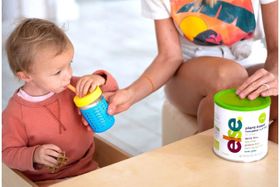Your Perfect Guide to Peanut Butter for Babies
Introducing peanut butter to babies can be a nutritious and delicious milestone. Learn the benefits, tips, and recipes for safely incorporating peanut butter into your baby's diet.
Updated May 31, 2024

Did you know that three million people in the United States are allergic to peanuts and tree nuts? In fact, a peanut allergy is the most common food allergy among children.
Before scientists understood the pathophysiology behind allergies, common allergies like those to peanuts were common. However, as more research and knowledge have been acquired, the scientific community is finding ways to help reduce the incidence of these kinds of allergies.
With the right approach, you may be able to lessen the risk or completely prevent your children from developing a peanut allergy. Read on to learn more about safely introducing peanut butter to babies.
» Discover this allergy-free infant cereal for a safe introduction to solid foods
When Can Parents Start Giving Baby Peanut Butter?
According to the American Academy of Pediatrics, parents should start giving baby peanut butter at about six months. This is around the same time that the child should start being introduced to solid foods. When first eating peanut better, it is best to introduce smooth peanut butter for the first time to reduce a choking hazard.
It used to be recommended to wait to introduce peanuts until a child turned a year old.
However, research has shown that waiting this long can actually have the opposite effect, increasing the likelihood that a child will have an adverse reaction to peanuts. A child who does not show signs of allergies can actually be introduced around 6 months of age.
» Learn the safe way to introduce allergens like peanut butter to your baby
How to Introduce Peanut Butter to Baby
Before introducing peanut butter to your baby, determine their allergy risk category:
If your child has severe eczema and/or an egg allergy, consult their pediatrician for advice. They may recommend allergy testing before introducing peanuts and may suggest introducing peanuts under medical supervision.
If your child has mild or moderate eczema, consult a doctor. It's generally safe to introduce peanuts around six months to reduce allergy risk later in life. However, avoid peanut butter until at least 4-6 months.
If your child has no signs of eczema or food allergies, you can offer peanut products once they start eating solids. Introduce other foods gradually, including peanut butter alongside fruit or vegetable puree.
Consult your pediatrician if you have concerns. They may allow you to introduce peanuts in their office for added safety.
» Unlock insights on supplements for kids with food allergies
How to Avoid Choking With Peanut Products
The best way to prevent choking is to avoid feeding your child whole peanuts. Peanuts in their whole form are a choking hazard up until 4 or 5 years old. You should also avoid giving your child chunky peanut butter as it could be difficult for them to swallow. The goal is to reduce the choking hazard for babies and give them the best peanut butter experience.
We also recommend that you avoid giving full spoonful's of peanut butter to your child. The consistency can cause the child to get peanut butter stuck in their mouths, which can also become a choking hazard. Instead, you can thin peanut butter out using water, and use it as a drizzle instead.
Another way to introduce could be to give your baby one peanut puff as long as they are able to easily chew this. In general it is a good idea to practice safe eating when giving a baby or toddler the peanut protein.
» Learn safe feeding practices for toddlers, including tips to prevent peanut butter choking
The Best Ways to Introduce and Serve Peanut Butter to Babies
Depending on your child's preferences, you'll start to form routines and recipes that work for them. However, when you're first starting out, you may need to try different kinds of foods to see what your child likes.
Whenever you serve peanut butter, you should make sure it's smooth and thin as mentioned above.
In the beginning, you should avoid chunky peanut butter and whole peanuts. Both are choking hazards.
Let's jump into some great recipes for your children!
Peanut Butter Recipes for Babies
Peanut Butter Puree
Peanut butter puree for babies is very nutritious. It contains healthy fats and proteins and is super easy to make.
To make peanut butter puree, all you need is creamy peanut butter and water. The water helps fluff the peanut butter, turning it into a yogurt-like consistency.
Add peanut butter and a little bit of water into a bowl and stir them together. The amount of peanut butter you'll need will depend on how much your child eats and how much you'd like to keep in the fridge later. The amount of water that you'll use will depend on the consistency that you want the peanut butter to be.
To make the ingredients easier to stir, use room-temperature peanut butter and lukewarm water.
As you're preparing the food, keep adding water until you get the creamy consistency that you want. If you're unsure of the consistency that you want, you should keep adding water until the mixture is no longer thick or sticky.
One of the best parts about this meal is that you can store any leftovers that you have in the fridge for up to five days.
Peanut Butter Puffs
Peanut butter puffs are a store-bought item that allows your kids to chow down without any meal-time prep from you. You can find these snacks at your local grocery store or online stores like Amazon. The most popular brand is Bamba Puffs.
Bamba Puffs come in a great size for babies. They are big enough that your baby can suck on them but small enough that they pose less of a choking risk. They also dissolve in your baby's mouth.
Some other newer brands include Earth's Best and Puff Works Baby.
Peanut Butter Toast
Peanut butter toast is another great snack for your baby as you're introducing them to peanuts. All you need to do is spread a thin layer of peanut butter on a piece of toast, or create a thin peanut sauce and use it as a drizzle on strips of toast.
Be sure to cut the peanut butter toast into pieces that are at least as big as your finger. You want to make sure that the pice is too big for the baby to choke on. If the piece is larger, they're going to be less likely to try to shove the entire thing in their mouth.
To prevent pieces of the bread from getting stuck to the roof of your child's mouth, you should lightly toast the bread. You don't want the bread to be too hard or too soft.
Peanut Butter Powder
Lastly, we want to introduce peanut butter powder for babies. To make peanut butter powder, you just need to grind the nuts into powder. You can do this using a food processor or you can mash them up manually with a fork.
Once you've got fine pieces of peanuts, you can sprinkle this powder onto other foods like oatmeal.
If you're going to do this the first time that you introduce your baby to peanuts, you should make sure there aren't any other potential allergens in the dish. If your baby has a reaction, you want to be confident that the peanuts are the culprit.
» Learn how to make this yummy peanut butter banana shake
Advice to Parents Who Are Giving Baby Peanut Butter
Before introducing peanut butter, start with low-allergy-risk foods like baby oatmeal, cereal, fruits, and pureed vegetables. Introduce one new food at a time and wait two to three days before adding another. Watch for signs of intolerance or allergic reaction, such as diarrhea, rash, vomiting, hives, sneezing, wheezing, itching, throat tightness, pale skin, lightheadedness, or loss of consciousness.
If any reaction occurs, stop the food and contact your pediatrician. If you suspect anaphylaxis, call 911 immediately. Gradually introduce higher-risk foods like milk, egg, soy, wheat, peanuts, tree nuts, fish, and shellfish after your child tolerates initial solids. Consult your pediatrician if there are allergy concerns. Ensure foods are in appropriate forms for your baby.
» Discover tips for managing peanut butter and other food allergies
Shop for Your Baby
No matter whether you're getting ready to introduce peanut butter for babies or another food, you want to make sure that you're giving your child the very best. We know that parents are concerned about their children's nutrition, especially with all of the snacks and food available for kids today.
With our products in your kitchen, you'll know that your child will have access to an organic, dairy-free, soy-free, gluten-free, corn syrup-free, non-GMO option for their health.
Our family at Else is dedicated to making plant-based, complete, whole food-based nutrition for toddlers and kids.
Frequently Asked Questions
Why should I introduce peanut butter early?
Introducing peanut products early in your baby's life can help the immune system recognize the peanuts earlier. This means that your child is less likely to have an adverse reaction to the food.
In some children, early introduction of peanuts can lessen their future reaction to the food product.
In some children, early exposure can completely get rid of the reaction altogether.
When in doubt, you should ask your pediatrician where to start when it comes to peanut butter products for your child.
What Should I Do Before Giving Peanut Products to My Baby for the First Time?
First, you should talk to your child's pediatrician to make sure that he/she knows that you're planning on introducing peanut butter to your child. The pediatrician may have different recommendations. There could even be a red flag that you don't know about, such as signs of eczema.
If your baby does have these kinds of signs, your child may need an allergy test. You may also need to see a pediatric allergist help your child grow out of these kinds of allergies.
How Do I Introduce Peanut Products to My Child?
Make sure that you're introducing peanuts into your child's diet when they're healthy. Otherwise, you're not going to know what symptoms to look out for in association with their illness or their potential reaction. It also ensures that their immune system will be okay to fight against a reaction if there is any problem with the peanuts.
If your child is displaying a fever, diarrhea, vomiting, or similar symptoms, hold off on introducing any kinds of new foods.
Unless otherwise directed by your child's physician, your child should be trying peanut products for the first time while they're at home. Some children may have their first taste while in a pediatric clinic to ensure that they get medical care in case something happens.
You should make sure that you aren't giving their first taste while they're in a restaurant, at daycare, or in another public place where you can’t supervise closely or access medical care urgently if needed.
What should I do before giving peanut products to my baby for the first time??
First, you should talk to your child's pediatrician to make sure that he/she knows that you're planning on introducing peanut butter to your child. The pediatrician may have different recommendations. There could even be a red flag that you don't know about, such as signs of eczema.
If your baby does have these kinds of signs, your child may need an allergy test. You may also need to see a pediatric allergist help your child grow out of these kinds of allergies.
How do I introduce peanut products to my child?
Make sure that you're introducing peanuts into your child's diet when they're healthy. Otherwise, you're not going to know what symptoms to look out for in association with their illness or their potential reaction. It also ensures that their immune system will be okay to fight against a reaction if there is any problem with the peanuts.
If your child is displaying a fever, diarrhea, vomiting, or similar symptoms, hold off on introducing any kinds of new foods.
Unless otherwise directed by your child's physician, your child should be trying peanut products for the first time while they're at home. Some children may have their first taste while in a pediatric clinic to ensure that they get medical care in case something happens.
You should make sure that you aren't giving their first taste while they're in a restaurant, at daycare, or in another public place where you can’t supervise closely or access medical care urgently if needed.
What to do when an allergic reaction occurs?
Food allergies in children can vary in severity, with reactions occurring immediately or later, depending on symptoms. Anaphylaxis manifests as multiple symptoms simultaneously, such as skin reactions, swollen tongue or lips, runny nose, sneezing, wheezing, and nausea, posing a life-threatening risk. If you suspect an anaphylactic reaction, seek immediate medical attention at the nearest emergency room.
If your child has a known allergy, schedule an appointment with their pediatrician or allergist for proper evaluation and treatment. Specialized medical professionals can identify specific allergies and provide appropriate management.
The content and advice provided in this article is for informational purposes only and is not a substitute for medical diagnosis, treatment, advice for specific medical conditions. Always consult a pediatrician to understand the individual needs of your child.








